Old Homes of Prince Edward
Published 5:29 pm Thursday, October 29, 2015
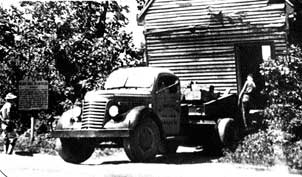
- This 1944 photo shows the Slate Hill office being moved to the HSC campus where it is now enshrined as “The Birthplace” of the College. A.L. Phillips & Son, a Richmond contractor, handled the move.
Slate Hill – Part 2
Last in a series
Dr. Ray A. Gaskins
Professor Emeritus HSC
It was during the late 1890s that Major Venable bought the old UTS property (including Atkinson Hall, Winston Hall, Venable Hall, Penshurst, Middlecourt, and The Maples) and gave it to HSC, and had a swampy area on campus drained and built an athletic field that from 1895 to 1985 was officially Venable Field. It was renamed Fulton Field in 1985, after Coach J. Stokley Fulton (1929-1985).
In 1906 Major Venable sold Slate Hill to Alice V. Smith, of Ridgefield Park, New Jersey, for $5,500 (now 533 acres). In 1910 John Fletcher Gilreath (1859-1931), of Georgia, bought Slate Hill from Smith for $5,333 (still 533 acres).
Gilreath, a preacher by trade, needed help running the 533-acre farm and he had it. After John B. McFarland died in Georgia, his widow, Anna Louise Hamilton (1849-1934), married Gilreath in May 1888. So he had a made-to-order workforce in his stepchildren, from oldest to youngest, Marvin Hamilton McFarland (1878-1956), Lucy M. McFarland (1880-1960), Joseph Gordon McFarland (1884-1964), and Bonnie Quillan McFarland (1885-1959). All four of the McFarland children moved with John and Anna from Floyd County, Georgia, to Slate Hill in 1910.
In 1915 the Gilreaths bought the Baskerville House, “the grandest house in the village.“ Located on campus on a 30-acre farm on Seminary Road (called Via Sacre, “Sacred Way,” even before the UTS moved to Richmond in 1898), between The Maples and the Union PSCE Cemetery, it was named for its first known owner, Charles A. Baskerville (1845-1896; CSA, HSC 1861). Built about 1870, the Baskerville House was not old enough to be inventoried by the WPA, so we will give some of its history here.
When Charles enlisted in the Confederate Army on April 21, 1862, he was commissioned a 2nd Lieutenant in Company E, 1st Virginia Infantry. On September 10, 1864, he was promoted to 1st Lieutenant. At Appomattox on April 9, 1865, he was paroled, and later that year married Alice Merle Sampson (1846-1924), daughter of Dr. F.S. Sampson (1814-1854), of UTS. Charles made his money as a merchant and put his money to good use raising thoroughbred horses on his 30-acre farm, much to the delight of the HSC students.
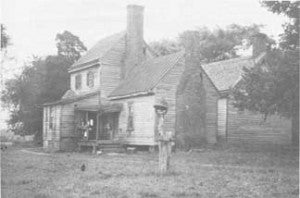
This rare rear-view of Slate Hill was taken in 1939, when the McFarland Brothers owned it and the Franklins and Chapmans were still living there. Its size was put to good use by Uncle John and Aunt Bet Venable in the 1870s, 80s, and 90s as a boarding house for Prince Edward Academy and HSC students.
After living in the Baskerville House for only six years, in June 1876 Charles sold it to the College. In 1890 the College sold it to Professor Walter Blair (1835-1909; CSA, HSC 1855). After graduation Blair was hired by the College as a Latin tutor, was promoted to assistant professor in 1857, and to full professor in 1859. In 1860 he went to Germany on leave to study for two years. Upon the outbreak of the Civil War, he immediately returned home and enlisted as a private in the Richmond Howitzers. By 1865 he was Battalion Sergeant Major—the highest rank for a noncommissioned officer. Apart from ringing in the ears (now called tinnitus), compliments of the howitzers, Blair survived the war unscathed and resumed his post at HSC. In 1874 he married Ellen Donnell Smith, of Baltimore.
Blair retired in 1896, moved to Richmond in 1899, and died in Atlantic City, NJ, on September 11, 1909. Gilreath bought the Baskerville House from the widow Ellen for $4,500—almost as much as he paid for Slate Hill—but it had 22 rooms and all the modern conveniences (except electricity, which did not come to Hampden-Sydney until 1919). His extended family moved there, leaving Slate Hill to renters and farm hands.
In 1929 the McFarland Brothers bought Slate Hill from their 69 year-old stepdad for a mere $5,000 (now 543 acres). Quillan remained with her brothers, but years earlier Lucy married Clinton H. Jones (1869-1947), of Buckingham, and moved out. In 1934 the McFarlands—Marvin, Gordon, and Quillan—inherited the Baskerville House.
The McFarland Brothers had been confirmed bachelors all their lives. Then, in May 1941, 62 year-old Marvin surprised everyone by marrying 25 year-old Annie Belle Chapman (1916-2006), daughter of William McKinley Chapman (1896-1980) and Daisy Belle Franklin (1893-1921), of Buckingham. Annie was a seamstress in Farmville, living on Beech Street, but gave all that up the minute she married Marvin, and moved to the McFarland farm on campus. There were now three dwellings on the campus farm: one built for the newly weds, a tiny one for Gordon, and the Baskerville House for Quillan.
Why did Annie marry Marvin, who was old enough to be her grandfather? You may be thinking that she married him for Slate Hill, but by 1941 it had become a shadow of its former self. She told Dolly Worthy later: “The kitchen floor was so rotten I could not walk across it for fear of falling through.” (In Today and Yesterday in the Heart of Virginia (1935) Slate Hill was described as “much dilapidated.”)
Annie had known Marvin for years. During the Great Depression her maternal grandfather, Samuel D. Franklin (1869-1950), a “gentleman farmer,” found himself homeless. The McFarland Brothers made him an offer he couldn’t refuse. He could live at Slate Hill, rent-free, in exchange for overseeing the farm. Thus, in the early 1930s, he moved into Slate Hill with his extended family, which included Annie and her three brothers—Willie, John, and Paul. As a young lady Miss Annie pretended to be “Mistress of Slate Hill.” Now that she was Mrs. Annie, the pretending was over, she was Mistress of Slate Hill, but she was living at the McFarland farm on campus. She had the best of both worlds.
In July 1943 the College Librarian, Mrs. Willa Boysworth (1905-1988), came up with the idea of moving the Slate Hill office to campus and enshrining it as “The Birthplace” of the College. She took the idea to President Emeritus Eggleston, who thought it was a terrific idea and he took it to President Gammon, who agreed. The McFarland Brothers were approached and they agreed to give the office to the College. (Willa replaced Librarian Paul Livingston Grier, who was commissioned an ensign in the US Navy on May 20, 1942. A year earlier, May 17, 1941, fire destroyed the old library at HSC, along with 20,000 reference books. Willa served until Paul returned in 1946.)
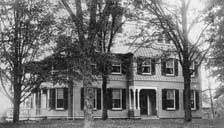
Searching through old Kaleidoscope yearbooks, we found many photos of unidentified campus homes, but this 1895 photo of a beautiful campus home was special. We then found a much smaller 1893 photo that had “Prof. Blair’s house” written beneath it in perfect longhand. By comparing the two photos, we are convinced that this is the Baskerville House in 1895, when the Blairs still lived there.
Most sources say that the office was moved to the College in 1944, but The Record of The Hampden-Sydney Alumni Association, Volume 36, Number One, October 1961, states: “on that hot July day in 1945 the road from Slate Hill via Mercy Seat Church to Hampden-Sydney was cleared and the office lifted and moved by truck to its present location between Westminster [Atkinson] Hall and the College Shop [Cabell House].” It is still in this location today (see photos).
So was the office moved in 1944 or 1945? Since the student newspaper, The Tiger, was not published in 1944 or 1945, we were unable to use this source; however, a front-page story in The Herald on September 29, 1944, confirms that 1944 is correct. A subsequent story and photo in The Tiger on April 1, 1952, gives July 1944 as the date, and shows the office restored but virtually sitting on the ground. It would not be raised and placed on its present foundation for almost 50 years.
In June 1951 the Baskerville House burned to the ground—accounts of the fire called it the McFarland House. Instead of rebuilding it, the McFarlands made do with the two remaining dwellings. The College acquired the farm in 1969, where the Bortz Library now sits. (After selling the farm to the College, Annie built a house on McFarland Lane, which also sits on part of the old farm.)
In July 1952, Christopher Stabile, of New York, bought Slate Hill farm. He was planning on moving his family there in September, but the morning after he signed the purchase agreement, he died in his cabin at Boxwood Tourist Court on Farmville Road, where The Bakery South is located today. His widow asked that the sale be vacated and this was agreed to, enabling the Springston family to purchase the farm in January 1956 for $23,000.
According to Dolly Worthy: “By the 1950s, so much of the interior of Slate Hill had been sold off or stolen [e.g., the staircase and mantels] that what was left was sold to A. D. Hobgood.”
In 1971 Mr. Hobgood dismantled the house, removed all of the material, and carefully stored it for future use. In 1979-80, he used most of this material in the construction of another house about 8 miles south of the Slate Hill site. This new house, in the Mt. Pleasant Community, was named “Slate Hill Anew.” All that is left at the Slate Hill site is the foundation, the well, and the family cemetery.
Starting as an 800-acre farm in 1760, the size of the Slate Hill tract changed over the years as chunks were spun off and bordering lands were purchased, e.g., a 23-acre piece adjoining Slate Hill was purchased from John B. Dupuy in 1769, and a small triangular piece (3.75 acres) was sold to Mercy Seat Baptist Church in 1870. By the time the Worthys
purchased it from the Springstons in 1958, it was less than 470 acres. In 2005 Dolly sold 252 acres, including the old home site and cemetery, to HSC.
In a long letter to The Herald on April 15, 1927, Miss Addie, daughter of Capt. Andrew Reid Venable, stated: “An effort is being made to restore the grave yard at Slate Hill and place a suitable monument there.” This turned into a very long project for Miss Addie. More than ten years later, on November 4, 1938, a front-page story in The Herald detailed her progress: “Miss Addie Venable is in charge of arrangements for selecting the big boulder, which will be brought from Burkeville and erected on the site of the old Venable Cemetery at Slate Hill.” On August 20, 1939, more than 12 years after her original announcement, the monument was dedicated, and Miss Addie lived to see it. She died the following year.
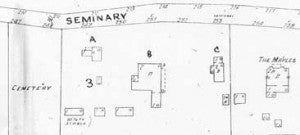
Three dwellings are shown on the McFarland Farm on this 1942 Sanborn Fire Map of Hampden-Sydney College. Gordon used dwelling A, the smallest of the three, built after 1915. Quillan occupied dwelling B, the Baskerville House. Dwelling C was built in 1941 for the newly weds, Marvin and Annie. You can see five other outbuildings on the farm. On one side is the Union PSCE Cemetery, and on the other is The Maples.
The huge monument, displaying the Venable coat of arms on its northern side and a large bronze plaque on its southern side, serves as a tombstone for Nathaniel and Elizabeth. The top of the plaque reads: “Captain Nathaniel Venable 1733-1804. Planter. Vestry Clerk of French’s Church, St. Patrick’s Parish. Member of the House of Burgesses 1766-69. Member of the Prince Edward Committee of Safety. Captain in the Revolutionary War. Member of the House of Delegates. Member of the Virginia Senate 1780-82. Justice of the Peace Prince Edward County. County Lieutenant of Prince Edward. A founder of Hampden-Sydney College and Trustee until 1804.” (The County Lieutenant, appointed by the Colonial Governor, was “an office which combined the functions of commander-in-chief of the militia with that of patron saint to the community.”)
The bottom of the plaque reads: “Elizabeth Michaux Woodson Venable 1740-1791. Wife of Nathaniel Venable and mother of fourteen children, seven of whom are buried here. Of such as these were the corner stones of our nation.” We have never seen a published list of the seven children buried at Slate Hill, so we will publish one here. Six children never married: Anne (1767-68), Frances (1778-99), Nathaniel E. (1776-1801), Agnes (1771-1802), Mary (1773-1807), and Dr. Thomas (1782-1809). The seventh child is Richard N. (1763-1838), who is buried beside his wife, Mary Morton (1779-1839). All ten of the Venables mentioned thus far were buried in unmarked graves.
In addition, Richard’s son, William H. (1798-1856), granddaughter, Magdalen McD. Venable Dickinson (1826-1852), and great granddaughter, Lena McD. Dickinson (1852-57), are buried here. Also here is another of Richard’s sons, Richard, Jr. (1806-1844) and his wife, Mrs. Magdalen [McCampbell] Venable (1807-1856). These last five have headstones and footstones, bringing the total number of known burials to 15.
Slate Hill Cemetery is a walled cemetery, measuring 43 feet by 63 feet. The stonewalls are three feet high and 8 to 10 inches thick, with a 12 inch wide and 4 inch thick top layer of flat stones. There is no iron gate to rust away. Instead, a unique double set of stone steps permits easy ingress and egress for people, but keeps large animals out. The cemetery is in the backyard, about 200 feet from the house. The monument rises 74 inches above the ground, is 76 inches at its widest, and is 28 inches thick. Just the above ground portion weights more than 12,000 pounds. Its north-south orientation is 90-degrees out of phase with the east-west orientation of the tombstones.
When we visited the site in 2004, weeds and small trees had taken over. Frost heaves and the demise of three or four large trees, which were still standing in the cemetery in 1939, created holes in the eastern wall. Marauding cows were then able to enter and push over tombstones. There were probably never more than five tombstones and they are still there, the oldest of which is 1844. All five were standing in 1939, two in 2004, and only one now. The tombstone supplier was “J.W. Davies, Richmond.” All of the other graves were either unmarked or marked with fieldstones.
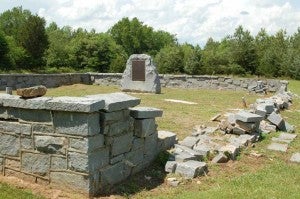
The Slate Hill Cemetery today (2015). It took Miss Addie Venable 12 years to renovate the cemetery, bring the six-ton memorial stone from Burkeville, and attach the bronze plaque for the August 20, 1939, dedication. The eastern wall, which was in perfect condition for the dedication, was falling down in 2004, and is now totally down. Of the 15 people known to be buried here, only five were buried in marked graves, and only one of those markers is still standing.
Every decade or so, the College sent a crew of “volunteers” to clean up the cemetery and take pictures. Unfortunately, during all of the many cleanups and picture takings, no one took individual close-up shots of the headstones or simply copied down the names and dates. The Code of Virginia, while it prohibits desecration of any grave, does not require landowners to maintain cemeteries located on their property, but it does (as amended in 2004) guarantee access to these cemeteries by relatives and genealogists.
PEC has never had a cemetery registration law so any cemetery, old or new, where all the occupants are known is the exception. Even well maintained cemeteries like Westview in Farmville have many unreadable headstones and unmarked graves. Other cemeteries like Old Jamestown on the banks of the Appomattox, which aren’t maintained at all, have graves that are so badly sunken that nearly all of the headstones have fallen into the graves. At Slate Hill Cemetery we know the names of 15 occupants, but there are many more occupants than that.
Now that HSC owns the Slate Hill tract (252 acres), things will be different they said. The cemetery will now be under continuing maintenance by the College, and the rest of the site will be used as a teaching tool for archeology by having students do “practice digs.” Ten years have now passed. The trees and weeds inside the cemetery walls have not been allowed to return, but the walls have not been repaired. The eastern wall is totally in ruins and the other three need shoring up. A small hole has developed in the concrete base on the north side of the monument. If this is filled with a bucket of concrete, it will be in good shape for another 76 years.
Walled cemeteries are a rarity in Prince Edward. We know of only three others and they are in good repair. Given its rarity and its history, the Venable Cemetery at Slate Hill is a Virginia antiquity worthy of preservation.
Finally, we do not know how the name Slate Hill originated. We do not know if there was ever a slate mine, but there was a small coal mine about 1880, worked for one year by Dr. J.D. Eggleston, Sr. (1831-1908) and R.M. Dickinson (1840-1898).
That pretty well covers the untold story of Slate Hill. We will have a few more things to say about Springfield and Kinderton, which were spun off from Slate Hill, in another article.
NB: After Marvin died n 1956, Annie became a campus fixture and remained a widow for 26 years, living on Via Sacre and working, first for Craddock-Terry as an inspector and then for ARA Food Services. Finally, in 1982, she married second Rowland C. Harkleroad (1921-1985), a widower for only a year. Annie, Gordon, and Marvin are buried in the McFarland family square at Westview Cemetery. Also in Westview is the Franklin family square. The Gilreaths and the McFarland Sisters are buried in the Jones family cemetery on Rt. 636 in Buckingham. The Baskervilles are buried in the Baskerville family square in the Union PSCE Cemetery. The Blairs are buried in Hollywood Cemetery in Richmond.


